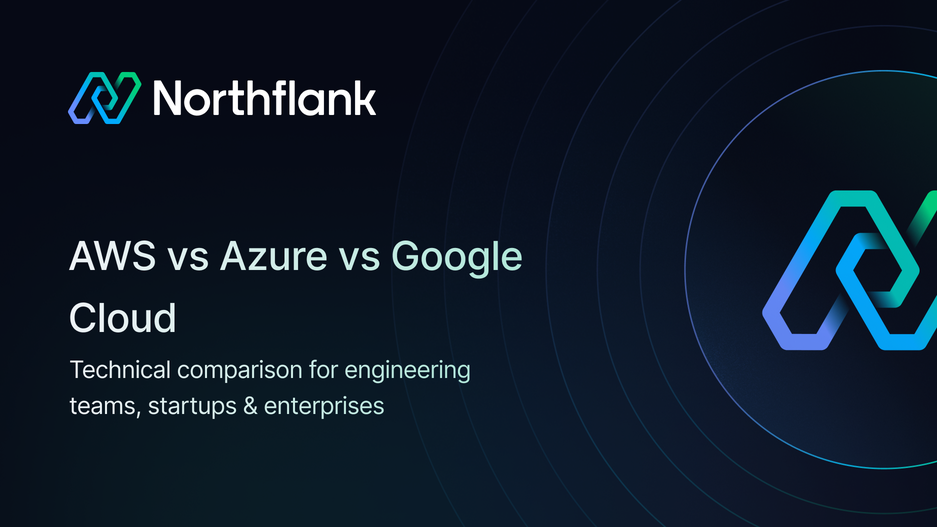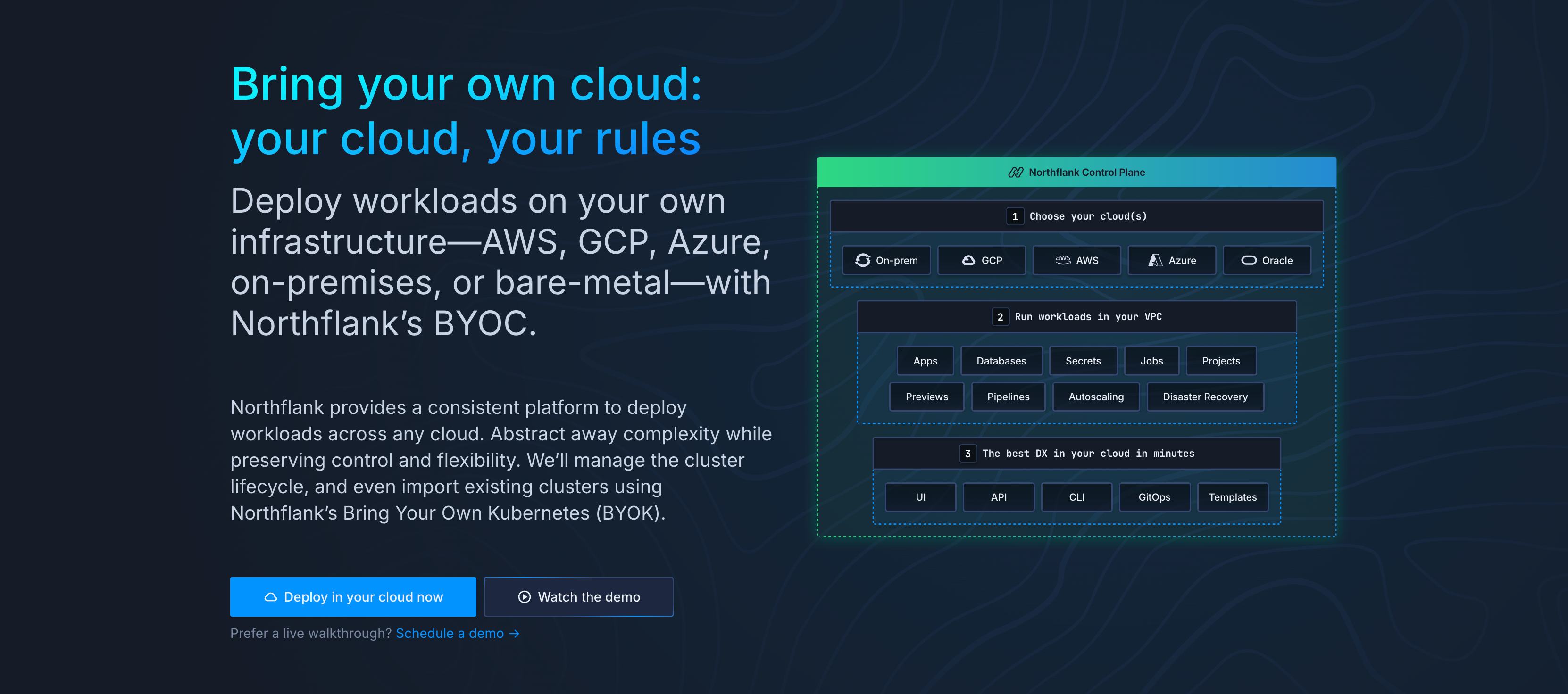

AWS vs Azure vs Google Cloud: comprehensive comparison for 2025
Comparing AWS, Azure, and Google Cloud usually comes down to four main concerns:
- "My team is drowning in complexity" - We need simpler infrastructure without losing control
- "Our cloud bills keep surprising us" - We need predictable, transparent pricing
- "We're worried about vendor lock-in" - We need flexibility to switch providers or go multi-cloud
- "Kubernetes is consuming our engineering time" - We need container orchestration without the operational burden
You could be selecting your first cloud provider, migrating from an existing one, or building a multi-cloud strategy. This comparison provides the information your team needs to make an informed decision.
One thing to consider upfront: You don't have to manage these platforms directly. Solutions like Northflank let you deploy across AWS, Azure, or Google Cloud while abstracting away infrastructure complexity. You keep control of your cloud account while getting a managed platform experience.
Before we go into details, let's quickly see how AWS, Azure, and Google Cloud compare based on complexity, cost predictability, vendor lock-in risk, Kubernetes management, and GPU/AI workload support:
| What you care about | AWS | Azure | Google Cloud | Northflank (platform layer) |
|---|---|---|---|---|
| Complexity | Overwhelming (200+ services) | High (Microsoft ecosystem dependencies) | Moderate (steeper learning curve) | Low (abstracts infrastructure) |
| Cost predictability | Poor (complex discounts, surprise fees) | Moderate (Hybrid Benefit helps) | Better (automatic discounts) | Transparent (pricing calculator) |
| Vendor lock-in risk | High (Lambda, RDS, DynamoDB) | Very high (Microsoft integration) | High (BigQuery, AI tools) | None (Bring Your Own Cloud (BYOC) model) |
| Kubernetes management | High (EKS needs expertise) | High (AKS still complex) | Moderate (GKE best, still work) | Zero (fully managed) |
| GPU/AI workloads | Good (P5 instances, Spot) | Good (Azure ML, OpenAI) | Excellent (TPUs, Vertex AI) | GPU support on Northflank cloud or your own cloud with automated spot orchestration (up to 90% savings) |
We'll break down the core services across AWS, Azure, and Google Cloud to help you understand which services are portable, which ones create lock-in, and how to plan your infrastructure decisions accordingly.
AWS offers the most comprehensive selection: EC2 (virtual machines), Lambda (serverless functions), ECS/EKS (containers), Fargate (serverless containers), and Elastic Beanstalk (PaaS). The range is impressive, but it can also be overwhelming when you're just trying to run an application.
Azure provides Virtual Machines with native Windows Server support, along with Azure Functions, AKS (Kubernetes), App Service (which is a better PaaS option than AWS's Elastic Beanstalk), and Container Instances. The entire platform assumes you're already deep in the Microsoft ecosystem, which works well if you are, but creates challenges if you're not.
Google Cloud gives you Compute Engine (VMs), Cloud Functions, GKE (the most advanced managed Kubernetes service, Cloud Run (their developer-friendly serverless container platform), and App Engine. There are fewer options compared to AWS, but the experience feels cleaner. If you're deciding between App Engine and Cloud Run, this comparison breaks down the tradeoffs.
All three offer similar database options, though the specifics differ:
- Relational databases: AWS RDS, Azure SQL Database, and Cloud SQL handle your MySQL, PostgreSQL, and SQL Server needs
- NoSQL databases: AWS DynamoDB, Azure Cosmos DB, and Google Firestore/Bigtable for flexible, schema-less data
- Data warehouses: AWS Redshift, Azure Synapse, and Google BigQuery (which leads the pack for analytics performance)
- In-memory caching: AWS ElastiCache, Azure Cache for Redis, and Google Memorystore for fast data access
Storage is comparable across all three. AWS S3, Azure Blob Storage, and Google Cloud Storage handle object storage similarly, and the same applies to file and block storage. Pricing and data transfer costs vary between providers, but functionally, they work the same way.
AI and machine learning are where the differences show up.
AWS provides SageMaker for ML workflows, plus pre-built services like Rekognition (computer vision) and Comprehend (natural language processing).
Azure offers Azure Machine Learning, which includes tools for building and managing ML models and workflows.
Google Cloud has Vertex AI, AutoML, and proprietary TPUs (Tensor Processing Units). If your core product is AI or data analytics, GCP's tooling is worth considering.
For AI workloads across any cloud: Northflank supports GPU deployments with automated spot GPU orchestration that reduces costs up to 90% while handling interruptions automatically. You can deploy on AWS, Azure, or GCP without needing to manage Kubernetes yourself. Learn more about deploying GPUs in your own cloud.
Pricing accurate as of October 2025. Cloud pricing changes frequently; always verify the current rates.
All three providers use similar pricing models, though the details vary:
This is the most expensive option but gives you maximum flexibility. AWS and Azure bill per-second with a 60-second minimum, while Google Cloud bills per-second with a 1-minute minimum. You can spin resources up and down whenever you need them.
Commit to using resources for 1-3 years and you'll get significant savings:
- AWS: Reserved Instances or Savings Plans (up to 72% off)
- Azure: Reservations or Savings Plans (up to 72% off)
- Google Cloud: Committed Use Discounts (up to 70% off)
This approach works well for predictable workloads, but you need to forecast your capacity accurately. Overprovisioning wastes money, while underprovisioning results in expensive on-demand pricing.
You can get up to a 90% discount in exchange for accepting interruption risk with spot instances. AWS gives you a 2-minute warning before interruption, Azure gives 30 seconds, and Google Cloud may change prices once every 30 days. This is ideal for fault-tolerant workloads like batch processing or CI/CD runners where interruptions don't break your workflow.
Google Cloud applies sustained-use discounts automatically (up to 30% off after 25% monthly usage). With AWS and Azure, you need to manually configure Savings Plans to get similar benefits.
Here's what you'd pay for a general-purpose instance (2 vCPU, 4GB RAM):
| Pricing model | AWS (t3.medium) | Azure (B2s) | GCP (e2-medium) |
|---|---|---|---|
| On-Demand | ~$30/month | ~$30/month | ~$24/month |
| Reserved (1-year) | ~$18/month | ~$17/month | ~$15/month |
| Spot/Preemptible | ~$9/month | ~$3/month | ~$6/month |
Note: Prices vary by region, instance type, and operating system.
Those list prices don't include everything you'll pay, though.
All three providers give you the first 100GB/month free for data transfer (egress), then charge $0.09-0.12 per GB depending on the provider and destination. Cross-region transfers cost extra. Even cross-availability-zone transfers within the same region add up, and these often get overlooked until the bill arrives.
Infrastructure costs you might forget
These vary by provider, but here's what to budget for:
- Load balancers: $18-25/month each (across all three providers)
- NAT gateways: $32-45/month plus data processing fees (AWS and Azure; GCP uses Cloud NAT with similar costs)
- Static IP addresses: $3-4/month when not attached to running instances (all providers)
- Storage: $0.08-0.23 per GB-month depending on performance tier and provider
These "small" costs compound quickly when you're running production infrastructure. So how do you manage all this without becoming a pricing expert?
Rather than spending weeks learning pricing models, Northflank's transparent pricing calculator shows exactly what you'll pay upfront.

With Northflank's Bring Your Own Cloud option, you can deploy into your own AWS, Azure, or GCP account and see platform costs and infrastructure costs separately. No surprises.

Northflank's autoscaling ensures you only pay for resources when needed, and spot instance support can cut compute costs by 90% with automated interruption handling. Learn more about cloud cost optimization strategies.
Now that you understand what each provider offers and how pricing works, let's look at how they handle the concerns that brought you here.
AWS has 200+ services, making it difficult to know where to start. Teams spend months figuring out which storage option to use, which compute service fits their needs, and how to configure IAM policies correctly.
Azure assumes you already know the Microsoft ecosystem. If you don't, you'll struggle with Resource Groups, Service Principals, and ARM templates. Frequent Portal redesigns don't help.
Google Cloud has fewer services, but their approach to networking and identity management differs enough from AWS and Azure to create a learning curve.
With Northflank: Connect your AWS, Azure, or GCP account, push your code, and deploy. Ultralight moved from AWS ECS to EKS without becoming Kubernetes experts.
AWS pricing requires expertise. Reserved Instances, Savings Plans, and Spot Instances each have different considerations, and understanding when to use which option takes time. Data transfer costs catch teams by surprise. Most teams overspend 30-40% before they figure out optimization.
Azure works better if you have Microsoft licenses (Hybrid Benefit saves 40%), but pricing stays opaque. You need to understand SKUs before you can estimate costs.
Google Cloud automatically applies sustained-use discounts, making costs more predictable. Data egress and networking fees still surprise teams, though.
All three providers lock you in through proprietary services. AWS uses Lambda, DynamoDB, and RDS. Azure ties you in with Cosmos DB, Azure Functions, and Active Directory. Google Cloud does the same with BigQuery, Cloud Spanner, and Vertex AI. Migration means significant rewrites.
With Northflank's Bring Your Own Cloud approach: Your deployment configurations stay cloud-agnostic. Deploy to AWS today, migrate to Azure tomorrow, or run multi-cloud from day one.
AWS EKS, Azure AKS, and Google GKE all require Kubernetes expertise. You're provisioning control planes, configuring worker nodes, setting up networking, managing autoscaling, and handling upgrades. GKE is the most mature managed Kubernetes service (Google created Kubernetes, after all), but "managed" still means you're doing significant operational work.
With Northflank: Kubernetes runs in the background handling all the operational complexity. You don't write Helm charts or debug pod networking issues. Autoscaling adjusts resources based on demand without manual configuration, and preview environments spin up automatically from pull requests so your team can test changes before merging.
Beyond choosing your initial provider, many teams eventually need to migrate between clouds for cost optimization, performance needs, compliance requirements, or access to specific features.
The technical work is significant: rewriting infrastructure-as-code for the new provider, rebuilding CI/CD pipelines, migrating databases with minimal downtime, reconfiguring networking and security, and retraining teams. This takes weeks or months of engineering time and creates service disruption risk.
Northflank abstracts provider-specific details, so your deployment configurations remain the same regardless of the underlying cloud.
You can migrate from on-premise to cloud, move between clouds without application changes, test multi-cloud strategies, or run hybrid cloud setups seamlessly.
Your team can connect a new cloud account, redeploy, and you're migrated.
Now that you understand what each provider offers and how they handle your concerns, here's a framework to help you decide:
| Provider | Choose if | Don't choose if |
|---|---|---|
| AWS | You need the widest service selection, you're building infrastructure-as-code from scratch with time to invest, you have dedicated AWS expertise, or global reach with the most regions is critical | You want transparent pricing, need to avoid vendor lock-in, or don't want to manage complexity yourself |
| Azure | You're deeply invested in Microsoft licenses (Office 365, Windows Server, SQL Server), hybrid cloud with on-premise Active Directory is required, you have Azure expertise in-house, or compliance requires specific Azure certifications | You're not in the Microsoft ecosystem, you want a developer-friendly experience, or cost transparency matters |
| Google Cloud | AI/ML and data analytics are core to your product, you need the best Kubernetes experience, you value cleaner and more predictable pricing, or you're already using Google Workspace | You need enterprise relationship depth like AWS/Azure or require the widest service catalog |
| Northflank (platform layer) | You want to build products instead of managing infrastructure, you prefer flexibility over commitment to one cloud provider, you need transparent pricing without surprise bills, you want Kubernetes benefits without operational complexity, your team's time is better spent shipping features, you need to support both traditional and AI workloads, you want to reduce GPU costs with spot orchestration, or you need to deploy across multiple clouds while maintaining portability | You want to manage infrastructure directly or are committed to learning one provider's ecosystem deeply |
You've seen what each provider offers, how they handle complexity and costs, and the migration challenges involved. The hyperscalers provide the infrastructure.
Your decision comes down to this: will you spend engineering time becoming infrastructure experts, or use a platform that handles operations while giving you portability?
Northflank works on top of AWS, Azure, or Google Cloud. You get hyperscaler infrastructure power without the operational burden. Your decision goes beyond selecting a cloud provider. It includes how you'll manage your infrastructure.
To see how this works with your infrastructure, start with Northflank's free developer plan or connect with an engineer to discuss your specific setup.